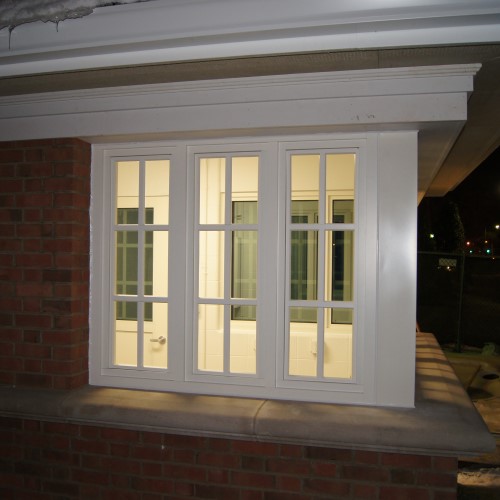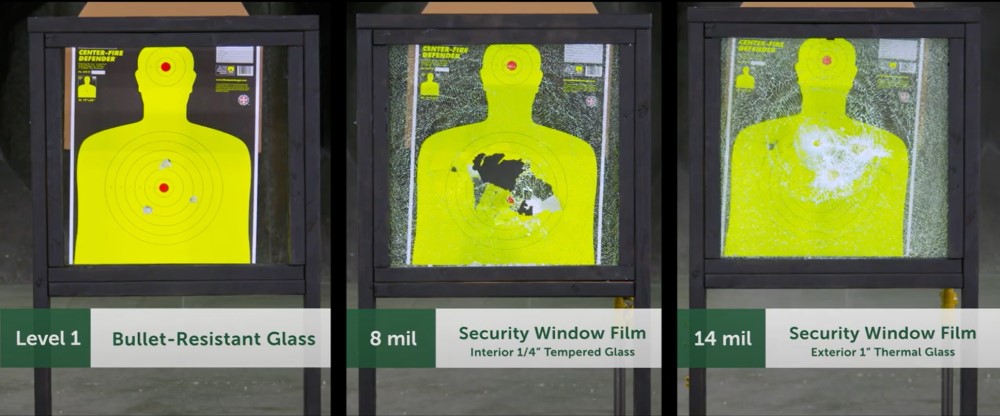No! Applying a thin coat of security window film to your existing windows will not make them bulletproof.
Unfortunately, there’s more confusion than ever about security window film and its uses, including as a bullet-resistant barrier. The most reliable way to ensure your windows can stop bullets is to use bullet-resistant glass.
In this blog, we break down everything you need to know about security film for windows and bulletproof glass: the differences between the two, the advantages and disadvantages of each product, and how to decide which is right for your setting.
How Does Window Security Film Work?
Security window film is typically a thin layer of polyester applied to existing window glass. Most security window film is two, eight, or 14 mil thick. This film holds broken glass together after it’s been shot or struck. This makes it incredibly challenging for an intruder to get through the window. So, if your goal is to prevent a window from shattering out, deter smash-and-grab thieves, or even withstand severe weather events, window security film really does work. (A reputable window film manufacturer, like 3M, should call out applications and testing so you can choose the right product.)
If your goal is to use security window film to stop bullets, then it doesn’t.
What About Ballistic Window Film?
Occasionally, companies describe security window film as “ballistic.” This term is misleading; a product keeps the glass from shattering when shot, but that does not mean it’s ideal protection from firearms. If window film truly is ballistic, it will likely have these distinct characteristics: be very thick itself and be applied to thicker than normal glass to be effective. Plus, it’s not uncommon to have to disassemble an exterior window unit entirely to install bulletproof window film, destroying its insulated properties. At this point, there’s little advantage to using film over traditional bulletproof windows or backglazing.
To understand if a security film product can stop bullets, check to see what standards the products are tested to, such as the UL 752 standard for ballistic materials. (TSS independently tests our bulletproof windows to this standard.) The UL 752 standard is a widely-accepted standard for determining how many shots a particular product can withstand from a particular type of firearm. For instance, if a product has a UL Level 3 rating, that means it can withstand three shots from a .44 Magnum pistol.
How to Decide Between Security Window Film and Bulletproof Glass
Both bulletproof glass and security window film have their place in a robust security plan. A good rule of thumb is to use security window film to protect property and bulletproof glass to protect people.
In situations where you’re not particularly worried about what’s on the other side of the glass, security window film is a good solution. For instance, security window film can effectively be used to prevent smash-and-grab theft, because there’s low threat to human life. Film may also be a good option if you want to reinforce a window or sidelite in a mostly-vacant area of your facility, such as an egress window.
Bulletproof glass is ideal when there are people on the other side of the glass. TSS’s robust design and manufacturing capabilities means we can create custom designs so your bulletproof barriers blend in with all types of architecture, including historic buildings. So, you can use bulletproof glass just about anywhere you need ballistic protection and peace of mind. Plus, because bulletproof glass is so durable, it’s incredibly difficult to get through, even when it is not specifically rated to withstand impact.

How Much Does Security Window Film Cost Compared to Bulletproof Glass?
Windows with bullet-resistant glass or glazing typically start at $2,000, depending on the material used and the protection level needed.
Based on the price difference, many people choose security window film over bulletproof glass. This is especially true in situations where there is a lot of pressure to make security upgrades quickly but a limited budget to work with. In these scenarios, we encourage stakeholders to speak with a security consultant who can help you identify the most vulnerable points of your facility and recommend the best places to use bulletproof glass and security window film. They can also make suggestions for which projects to tackle first and what can wait until future years and budget cycles.
Speaking with an expert at the start of your project can save you time and money. Too often, we see companies rush into their improvement projects, make the wrong choice, and have to re-do everything a year later. Our goal is to make the most of your budget, and will always provide practical advice for improving your security.
TSS Is Ready to Help Secure Your Facility
TSS is proud to help companies across the country improve their physical and psychological safety with all types of bulletproof barriers. To get an expert opinion about what type of bulletproof glass you might need compared to film, design a system, or get a quote, please don’t hesitate to contact us.
The product pricings are approximations only and are not intended to replace the quoting process. TSS cannot guarantee that the pricing here will be reflected in your official project quote.


